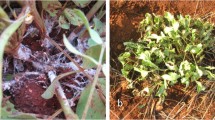Abstract
Partial resistance to Sclerotinia sclerotiorum based on stem lesion advancement was assessed for nine wild pea genotypes from five geographic origins and two cultivated genotypes, when peas were inoculated and incubated at all combinations of five temperatures (15.6, 18.3, 21.1, 23.9, 29.4°C) and four period(s) of high relative humidity (PHRH; 12, 24, 48, 72 h). PHRH of 12 and 24 h should not be used when screening plants for resistance to S. sclerotiorum regardless of the incubation temperature, since stem lesions are rarely (2.7%) visible at 12 h and there were no significant differences (P ≤ 0.05) in lesion lengths among and within genotypes at all temperatures assessed after 24 h. However, PHRH of 48 and 72 h are recommended for use to assess partial resistance since significant differences in stem lesion length among the genotypes were observed and characterized for these periods. Genotypes with cool (15.6 and 18.3°C) versus warm (23.9 and 29.4°C) temperature partial resistance to S. sclerotiorum were identified, and genotypes PI 240515 and PI 169603 appear to have the best cool and warm temperature partial resistance, respectively, among the genotypes assessed. A temperature of 21.1°C was the optimal temperature favouring lesion advancement for the majority of the genotypes evaluated. PI 169603 demonstrated the best partial resistance to S. sclerotiorum across the widest temperature and PHRH ranges and is recommended to plant breeders as the best single genotype to develop future cultivars with improved partial resistance to S. sclerotiorum based on stem lesion advancement.
Similar content being viewed by others
References
Agrawl SC, Prasad KVV (1997) Diseases of lentil. Science Publishers, Inc., Enfield
Biddle AJ (2001) Sclerotinia white mold. In: Kraft JM, Pfleger FL (eds) Compendium of pea diseases and pests, 2nd edn. The American Phytopathological Society, St. Paul, pp 30–31
Blanchette BL, Auld DL (1978) Screening field peas for resistance to white mold. Crop Sci 18:977–979
Farr DF, Rossman AY (2011) Sclerotinia sclerotiorum. In: Fungal Databases, Systematic Mycology and Microbiology Laboratory. United States Department of Agriculture, Agricultural Research Service. Available via DIALOG. http://nt.ars-grin.gov/fungaldatabases/index.cfm of subordinate document. Accessed 4 Apr 2011
Fenwick HS (1969) Diseases of Austrian winter pea in Idaho. Plant Dis Report 53:918–920
Hall R, Nasser LCB (1996) Practice and precept in cultural management of bean diseases. Can J Plant Pathol 18:176–180
Hampton RO, Ford RE (1965) Pea diseases in Washington and Oregon, 1964. Plant Dis Report 49:235
Kraft JM, Larsen RC, Inglis DA (1996) Diseases of pea. In: Allen D (ed) The pathology of food and pasture legumes. CAB International, Wallingford, pp 325–370
Muehlbauer FJ, Short RW, Kraft JM (1983) Description and culture of dry peas. Washington, USA, United States Department of Agriculture, USDA-ARS. Agric Rev and Man 37:1–92
Porter LD, Hoheisel G, Coffman VA (2009) Resistance of peas to Sclerotinia sclerotiorum in the Pisum core collection. Plant Pathol 58:52–60
Steadman JR (1979) Control of plant diseases caused by Sclerotinia species. Phytopathology 69:904–907
Acknowledgments
The author would like to thank the National Sclerotinia Initiative of the USDA-ARS for funding this research and Dr. Clare Coyne and personnel at the USDA WRPIS for providing the seed for this research project. The author would also like to thank Virginia A. Coffman and Andrea De Vries for their technical help in completing this research and Drs. Zahi Akannan Atallah and Nadav Nitzan for their critical reviews. Finally, the author would like to thank Dr. Marc Evans, Professor of Statistics, at Washington State University for his assistance with the statistical analyses.
Author information
Authors and Affiliations
Corresponding author
Rights and permissions
About this article
Cite this article
Porter, L. Selection of pea genotypes with partial resistance to Sclerotinia sclerotiorum across a wide range of temperatures and periods of high relative humidity. Euphytica 186, 671–678 (2012). https://doi.org/10.1007/s10681-011-0531-x
Received:
Accepted:
Published:
Issue Date:
DOI: https://doi.org/10.1007/s10681-011-0531-x




